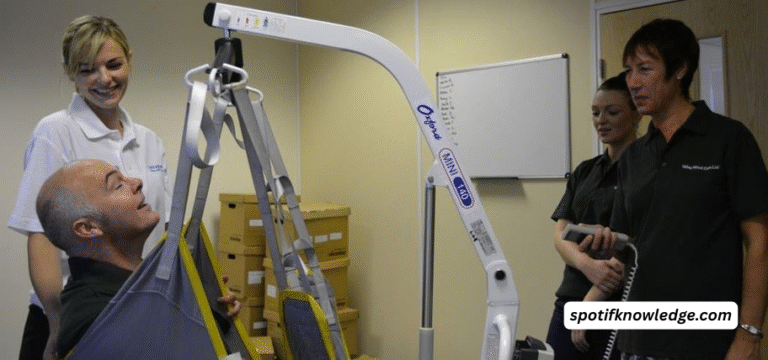If you’ve ever tried to move someone you love—really move them, from bed to chair or chair to toilet—you know the strain. It’s not just physical. It’s mental too. You’re balancing safety, dignity, and the awkward mechanics of lifting another person. And in the back of your mind, there’s that fear: what if I drop them? What if I hurt myself?
That’s where the humble stand hoist steps in.
It doesn’t get the same attention as high-tech hospital gear or fancy adjustable beds. But for carers in Australia—family members and professionals alike—a stand hoist can be the difference between manageable care and burnout.
Carers, the Silent Backbone
Australia leans heavily on carers. Some are paid, working in aged care facilities or disability support. Many more are unpaid—sons, daughters, spouses—quietly doing the work at home. And it’s tough. Caring for someone with limited mobility often means repeated lifting, bending, and steadying. Do it once, and you might be fine. Do it daily, for months or years, and the toll adds up.
Back injuries are widespread among carers. Shoulders too. Even wrists. And it’s not just about bodies breaking down—it’s the stress that piles on. The exhaustion. That creeping feeling of resentment or guilt.
A stand hoist doesn’t fix everything, but it lightens the load. Literally and emotionally.
So, What Exactly Is a Stand Hoist?
Imagine a sturdy frame on wheels with a supportive sling or harness attached. The person being moved doesn’t get lifted in the air completely—they’re assisted to a standing position, supported securely, then transferred from one place to another.
Unlike a full hoist, which is for people who can’t bear weight at all, a stand hoist works best for those who can still put some strength through their legs. It’s not about doing everything for them—it’s about giving just enough help so the transfer is safe and less taxing on everyone.
This matters. Because it means independence isn’t taken away. The person being cared for is still part of the process. They’re not a passive passenger. That’s a subtle but essential difference.
Injury Prevention—For Everyone
Let’s be blunt: lifting another human body is risky. There are no perfect grips or magical techniques. People tend to be heavy, unpredictable, and scared when they feel unstable. Carers who try to “muscle through” transfers are gambling with their health.
A stand hoist changes that equation. It takes most of the weight. It stabilises the movement. It gives both the carer and the person being moved confidence that no one’s going to topple sideways. And confidence matters—because a shaky transfer isn’t just dangerous, it’s frightening.
Think of it this way. A stand hoist isn’t just protecting carers from injury. It’s protecting relationships. Less stress, less pain, fewer tense moments where everyone’s nerves are stretched thin.
Burnout Is Real
Carer burnout isn’t always visible. It creeps in slowly—first as tiredness, then as irritability, then as emotional flatness. For many, it’s the constant physical demands that start the slide. Without equipment like a stand hoist, even basic daily routines—morning toileting, showering, getting to bed—become exhausting marathons.
The risk isn’t just that carers get hurt or worn out. It’s that they can’t keep going. Families end up scrambling for respite care or, in some cases, moving loved ones into facilities earlier than they wanted.
It’s a heartbreaking cycle. But stand hoists offer a pressure valve. They give carers back energy, reduce that constant background worry, and make the act of care more sustainable.
The Dignity Factor
Here’s something people don’t always say out loud: being carried or dragged into position doesn’t feel good. For the person being moved, it can feel infantilising, even humiliating.
A stand hoist flips that dynamic. It provides support without stripping away agency. The person being cared for can still participate—hold on, push through their legs, feel upright rather than helpless. That’s dignity. And dignity in daily routines, especially something as private as toileting or bathing, is worth more than most people realise.
Access in Australia
The good news? Stand hoists aren’t hard to find. They’re available through many equipment providers, and for those on the NDIS, they’re often covered if justified as “reasonable and necessary.” Some hospitals and rehab centres also arrange short-term rentals after surgery or illness, giving families a chance to trial one at home.
Costs vary, of course, but compared to the price of injuries, burnout, or early facility care, they’re small. And once you’ve seen the difference they make, it’s hard to imagine going without.
A Small Device, A Big Shift
At the end of the day, a stand hoist isn’t flashy. It’s not the kind of thing you’ll ever see on a TV ad or in a glossy lifestyle magazine. But in living rooms and bedrooms and aged care wings across Australia, it’s quietly transforming the way care feels—for both sides.
Less strain. Less fear. More dignity. More sustainability.
Sometimes the most essential tools are the simplest ones.
Final Thought
If you’re a carer—professional or family—don’t wait until your back gives out or your patience frays. Consider a stand hoist from CHS Healthcare. It’s not just equipment. It’s a relief. It’s safety. It’s one of those unglamorous little things that make an enormous difference, day after day, year after year.

